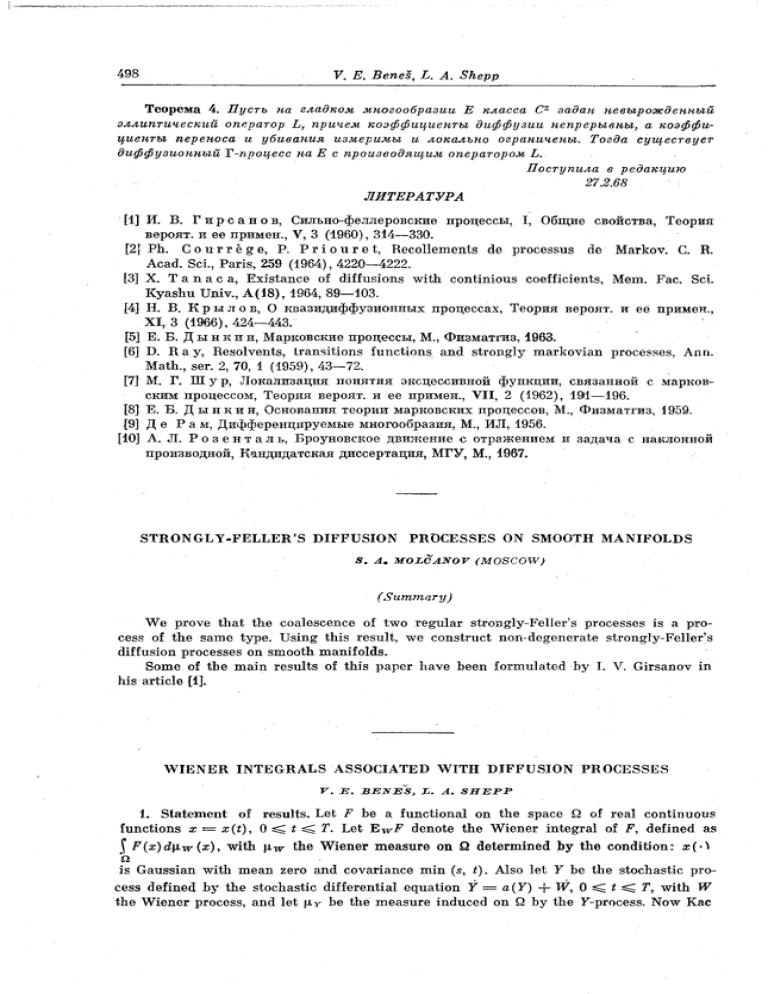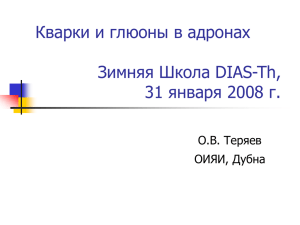Wiener integrals associated with diffusion processes
advertisement

498
V. E. Benes, L. A. Shepp
Теорема 4. Пусть на гладком многообразии Е класса С2 задан невырожденный
эллиптический оператор L, причем коэффициенты диффузии непрерывны, а коэффи­
циенты переноса и убивания измеримы и локально ограничены. Тогда существует
диффузионный Т-процесс на Е с производящим оператором L.
Поступила в редакцию
27.2.68
ЛИТЕРАТУРА
[1] И. В. Г и р е а н о в , Сильно-феллеровские процессы, I, Общие свойства, Теория
вероят. и ее примен., V, 3 (I960), 314—330.
[2] Ph. C o u r r e g e , P. P r i o u r e t , Recollements de processus de Markov. C. R.
Acad. Sci., Paris, 259 (1964), 4220—4222.
[3] X. T a n а с a, Existance of diffusions with continious coefficients, Mem. Fac. Sci.
Kyashu Univ., A( 18), 1964, 89—103.
[4] H. В. К р ы л о в , О квазидиффузионных процессах, Теория вероят. и ее примен.,
XI, 3 (1966), 424-443.
[5] Е. Б. Д ы н к и н , Марковские процессы, М., Физматгиз, 1963.
[6] D. R a y , Resolvents, transitions functions and strongly markovian processes, Ann.
Math., ser. 2, 70, 1 (1959), 43—72.
[7] M. Г. Ш у р , Локализация понятия эксцессивной функции, связанной с марков­
ским процессом, Теория вероят. и ее примен., VII, 2 (1962), 191—196.
[8] Б. В. Д ы н к и н , Основания теории марковских процессов, М., Физматгиз, 1959.
[9] Д е Р а м , Дифференцируемые многообразия, М., ИЛ, 1956.
[10] А. Л. Р о з е н т а л ь, Броуновское движение с отражением и задача с наклонной
производной, Кандидатская диссертация, МГУ, М., 1967.
STRONGLY-FELLER'S DIFFUSION PROCESSES ON SMOOTH MANIFOLDS
S. A. MOLCANOV (MOSCOW)
(Summary)
We prove that the coalescence of two regular strongly-Feller's processes is a pro­
cess of the same type. Using this result, we construct non-degenerate strongly-Feller's
diffusion processes on smooth manifolds.
Some of the main results of this paper have been formulated by I. V. Girsanov in
his article [1].
WIENER INTEGRALS ASSOCIATED WITH DIFFUSION PROCESSES
V. E. BENES,
X. A.
SHEPP
I. Statement of results. Let F be a functional on the space Q of real continuous
functions x — x(t), 0 sg: t ^ T. Let EWF denote the Wiener integral of F, defined as
J F(x)d\iw(x),
with \iw the Wiener measure on Q determined by the condition: x(A
'a
is Gaussian with mean zero and covariance min (s, t). Also let Y be the stochastic pro­
cess defined by the stochastic differential equation Y = a (Y) + W, 0 г£ t ^ T, with W
the Wiener process, and let Цу be the measure induced on Q by the Y-process. Now Kac
Wiener integrals associated with diffusion processes
499
Г
[1] has given a formula for EWF
in case p (x) = exp I — у \ V (x (t)) dt\, with F(-)
о
bounded, and Prokhorov [2] has shown that |x r ~ |iw with
T
T
^ — (ж) = exp | . о (x (t)) dx (t) — "2 \ «2 (» (0) <"} ,
(1)
о
о
whenever a(-) e Lipi. (See also Skorokhod [3]). We show that Kac's formula can be
obtained from Prokhorov's theorem.
2. Evaluating Wiener integrals by Newton's technique. A familiar technique for
ь
evaluating [ fdt is to find a function g with g' = f, so that £ fdt == g(b) —
a
a
— g- (a). In our context, to calculate, J i'djiw we find a measure v on Q with
- — = pt
i.e. such that the functional F is the Radon — Nikodym derivative of v with respect to
\iw T h e n E w . F = v(Q).
So far only two classes of Wiener integrals have been calculated or at least reduced
to more familiar problems:
т
(a) F{x) = e x p j — у \ f{t)x*(t)dt\
with / continuous [4];
о
T
(b) F (ж) = е х р | — у \ V(x(t))dt\
w i t h 7 ( - ) bounded [1]
The above technique can be used to find EWF in these cases. Numerous proofs of the
formulas thus obtained are known, but we feel that Newton's technique provides a simple
unified approach which is far from being exhausted. Case (a) has been treated in pre­
vious work of Shepp [4]; the desired measure v corresponds to a scale change in the
Wiener process. In case (b) the desired measures v correspond to diffusion processes.
(See Dynkin [5], vol. I, p. 11.) Use of Newton's technique in describing stochastic proces­
ses has been made by Skorokhod [9].
3. Kac's formula. For case (b) Kac [1] has given the following procedure for fin00
ding EWF: EWF =
00
\ q(T,y)dy
where ф (я, у) = \ e~s'g (t, y) dt is determined by
0
—00
the Schrodinger equation
Vtf|>», = (VsV + * ) * . 0 < | j / | < oo, s > 0; i M * , 0 - ) - * v ( « , 0+) = 2.
(2)
4. Diffusion. We consider a diffusion process Y(-) defined as the solution of the
stochastic differential equation [6]
Y(t)=a(Y(t))+W(t),
OsStsST,
in which the function a(-) describes the local drift, and W(l) is the Wiener process. We
restrict attention to the case Y(Q) = 0 , a(-) e Lipi. Here Picard's theorem implies that
for any continuous function W there is a unique У satisfying
т
Y (t)=\a{Y{u))du
+ W (t),
0<£<r,
0
the process Y(-) is a Markov process, and p(t, y) = ¥{Y(t) = y} satisfies the forward
equation [7] pf. + (w)v = ЧгРяу, with p(0, y) = 6(y).
т
5. Proof of Kac's formula from Prokhorov's theorem. T h e integral J
a(x(t))dx(t)
о
8*
500
V. E. Benes, L. A. Shepp
n
occurring in (1) is the «left-handed» stochastic integral [7] defined as lim 2 e ( s j - i ) • {XJ — ж,-_0, with ж,- = x(t}), 0 ^ h < t2 < ... < tn ^ T. It can be expressed in
terms of Lebesgue integrals by a method of ltd [8, Appendix 2]:
г
т
[a(x (J)) efo (i) = A(x (J1)) — 7з С a' (x (t)) dt,
(3)
о
о
z
where 4(z) = J a(a)du. We make the assumption (#) that F(-) is sucb that there is
о
a sulution a (•) of the Riccati equation
a' + a2 = F
(4)
with the property: a ( - ) e L i p i . (This supposition will be justified presently.) Using
this function a(-) to define the diffusion process Y(-), we find from (1), (3) and (4)
that
a(z)dz~1k\!V(x{t))dtY
о
^-=exp{ J
о
d\iY
F (*) = -Щ^
daw (*) exp [ - A (x (T))\.
Integrating with respect to Wiener measure, we obtain
EWF = J «"* <ж <T» du. y (*) = j e - A («) /> (Г, у) A,.
To see that our formula (5) is equivalent to Kac's (2), set g(t, y) — p(t,
Then
'.'Va?*'» = lh(Pve~A—ape~A)v
(5)
—oo
Я
= l/ie~A{pvv
y)e~A^>.
— 2apy — a'p + a2p) = j< + Va^S. '
(6)
by the forward equation and (4), Taking transforms gives
;
*ftfyy = ,$ + */аУф, ;2/=^0,
and the condition on t|),, follows from (6) by integration over (—8, e):
£
,
,
£
gy(t,&) — gv(t,— 8 ) ' = 2 \j ? t ( i , z ) d z + jj F (z) 9 (t, z) dz,
—e
,
—Is
£
£
% (s, 6) — ^ y ( s , - 8) = 2 ^ [si|) (s, z) — 6 (г)] dz + § 7 (г) ф(*, z) dz,
—г
—e .
iM»,.0-)-iM«,'0+) = 2 .
The exact conditions on V(-) such that assumption (*) holds are apparently not
simple. But for V(-) bounded and positive the existence of «(•) such that a + a2 = F
and a ( ; ) e Lipi, is ensured by the following
Lemma. / / 0 г^ F ^ к2, then the equation d-j-a2 = F has a solution «(•) with
6 < а (з) «S к.
P r o o f . Standard existence and uniqueness theorems guarantee that through any
point (x, a(x)) there passes exactly one trajectory a(-) satisfying a + a2 = F. Consider
the trajectories a(-) with 0 ^ e(0) ^ к. It is easy to see that these are bounded for
x > 0, never leaving the region R = [0, к]. Assume then that every trajectory a (•) with
a(0) Е Й has either а (ж) < 0 for some x < 0 or a(y) > к for some г / ' < 0 ; it is not
possible that both properties accrue to a (•), because а, г£ О at the boundary к, and a ^
^ 0 at the boundary 0, so once a trajectory is in R, it stays there. We will derive a
contradiction and so prove the lemma.
Интегралы Винера, связанные с диффузионными процессами
501
Case (1): For some хй < 0; х <. х0 implies V(x) = 0. Then the solution a(-) with
a(x) = 0 for x < Xo lies in Й.
Case (2): For some x0 < 0, ж < ж0 implies V(x) == A2. Then the solution a(-) with
a (x) = ft lies in Й.
Case (3): F ( i „ ) < ft2 for some sequence ж„ < 0, ж„-^оо and F(j/„) > 0 for
some sequence yn < 0, г/„ -*- — oo. For a trajectory a(-) with a(0) е Л , define
t« = inf {t : a(i) е й } ,
X = sup {a(0) : a(ta) = 0, e(0) 6 « ) .
Let a(-) be the1 solution with a(0) = X. Either a(ra) = 0 or a(t a ) = ft. In the latter
case find x < xa with V(x) < ft2. The trajectory b(-) with 6 (ж) = ft satisfies 6(») <
< a(u) and 6(0) < a(0) = X, so that a(-) crosses &(•)• This is impossible. In the for­
mer case find у < xa with V{y) > 0. The trajectory c(-) with c(y) = 0 satisfies c ( a ) >
>a(u) and c(0) > a(0) = X, so that a(-) crosses c(-). This contradicts the definition
of X and shows that the original supposition that every trajectory a(•) with о(0) е й
be outside R for some x is false. Hence there is a trajectory lying entirely in R.
It is obvious that if a(-), V(-) are bounded and d + a?- = F, then a(-) e Lipi.
BeH Telephone Laboratories, Incorporated
Murray Hill, New Jersey
Поступила в редакцию
25.1.67
REFERENCES
[1] M. K a c , On some connections between probability theory and differential and in­
tegral equations, Proc. 2nd Berkeley Sympos., Math. Statist, and Prob., 1951, 189—
215. (Русский перевод: М. Кац, О некоторых связях между теорией вероятностей,
дифференциальными и интегральными уравнениями, Математика (сб. перево­
д о в ) , ! (2) 1957,93—124),
[2] Ю. В. П р о х о р о в , Сходимость случайных процессов и предельные теоремы тео­
рии вероятностей, Теория вероят. и ее примен., I, 2 (1956), 177—238.
[3] А. В. С к о р о х о д , О существовании и единственности решений стохастических
дифференциальных уравнений, Сиб. матем. ж., 2, 1 (1961), 129—137.
[4] L. A. S h e p p, Radon — Nikodym derivatives of Gaussian measures, Ann. Math. Stat.,
37 (1966), 321-354.
[5] E. В. Д ы н к и н . Марковские процессы, М., Фйзматгиз, 1963.
[6] К. 11 б, Stationary random distributions, Mem. Fac. Sci. Kyoto Univ., Ser. A 28
(1953), 209—223.
[7] Дж. Л. Д у б, Вероятностные процессы, М., ИЛ, 1956.
[8] К. I t б, On stochastic differential equations, Mem. Amer. Math. Soc, 4 (1954).
[9] А. В. С к о р о х о д . Конструктивные методы задания случайных процессов, Успе­
хи матем. наук, 20, 3 (1965), 67—87.
ИНТЕГРАЛЫ ВИНЕРА, СВЯЗАННЫЕ С ДИФФУЗИОННЫМИ ПРОЦЕССАМИ
В. Е. БЕНЕШ,
Л. А. ШЕИ И (НЬЮ-ДЖЕРСИ,
США)
(Резюме)
Для V(-) и «(•)> связанных уравнением Риккати а + а2 = V, из формулы Про­
хорова
т
т
exp J a (x (t)) dx (t) — -. . a2(x(t))dt\
о
о
для производной Радона — Никодима (по мере Винера) меры, соответствующей диф­
фузионному процессу Y(Y = a{Y) + W, где W — винеровский процесс), выводится
метод Каца вычисления интеграла Винера от функционала
т
expj—1J
-.
о
V(x'(t))dt}.
•
•
,
.
-
•
"
.
.

